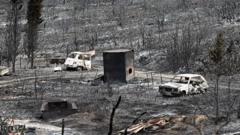The Aude region of southern France is grappling with a catastrophic wildfire that has left one elderly woman dead and created a desperate situation for many residents. French Prime Minister François Bayrou declared the fire a "catastrophe on an unprecedented scale" while surveying the affected areas, where the flames have scorched over 15,000 hectares—an area larger than the city of Paris.
The blaze, which originated near the village of Ribaute on Tuesday, has resulted in the injury of at least 13 individuals and left one person missing. As of now, 2,150 firefighters are tirelessly working to contain the flames, which are fueled by drought conditions and strong winds, with high summer temperatures exacerbating the situation.
Officials reported that it is France's most significant wildfire since 1949, and it could continue to burn for several more days. "The fire is still very active, and the conditions remain unfavourable," Lucie Roesch, the Aude prefecture's secretary general, told AFP. Several villages have been severely affected, prompting authorities to open 17 temporary accommodation sites for displaced residents, who are advised not to return to their homes.
The destruction is extensive: at least 25 homes have burned down, leaving over 2,500 households without electricity. Mayor Jacques Piraud of Jonquières described the extensive damage, with around 80% of the village burned and trees completely charred. In addition, many vehicles have burned out, and areas several kilometers away have reported the smell of smoke infiltrating homes.
President Emmanuel Macron has mobilized national resources to tackle the disaster and emphasized the importance of public caution. Firefighting efforts are supported by a fleet of water-bombing aircraft, as the fire spreads rapidly due to the dry vegetation and challenging environmental conditions.
Satellite images captured by Météo-France reveal the significant plume of smoke, visible even from space. As wildfires continue to pose a threat to the Mediterranean region, scientists warn of the increased vulnerability due to rising temperatures and drought—a scenario amplified by the removal of natural vegetation that traditionally helped curb wildfire spread.
In total, nearly 15,000 hectares have burned across France this summer, accounting for over 9,000 separate fires, with the Aude blaze now equating to the damage of all prior incidents combined.
As the situation evolves, PulseWire encourages residents and witnesses to share their experiences and photos to keep the community informed.
The blaze, which originated near the village of Ribaute on Tuesday, has resulted in the injury of at least 13 individuals and left one person missing. As of now, 2,150 firefighters are tirelessly working to contain the flames, which are fueled by drought conditions and strong winds, with high summer temperatures exacerbating the situation.
Officials reported that it is France's most significant wildfire since 1949, and it could continue to burn for several more days. "The fire is still very active, and the conditions remain unfavourable," Lucie Roesch, the Aude prefecture's secretary general, told AFP. Several villages have been severely affected, prompting authorities to open 17 temporary accommodation sites for displaced residents, who are advised not to return to their homes.
The destruction is extensive: at least 25 homes have burned down, leaving over 2,500 households without electricity. Mayor Jacques Piraud of Jonquières described the extensive damage, with around 80% of the village burned and trees completely charred. In addition, many vehicles have burned out, and areas several kilometers away have reported the smell of smoke infiltrating homes.
President Emmanuel Macron has mobilized national resources to tackle the disaster and emphasized the importance of public caution. Firefighting efforts are supported by a fleet of water-bombing aircraft, as the fire spreads rapidly due to the dry vegetation and challenging environmental conditions.
Satellite images captured by Météo-France reveal the significant plume of smoke, visible even from space. As wildfires continue to pose a threat to the Mediterranean region, scientists warn of the increased vulnerability due to rising temperatures and drought—a scenario amplified by the removal of natural vegetation that traditionally helped curb wildfire spread.
In total, nearly 15,000 hectares have burned across France this summer, accounting for over 9,000 separate fires, with the Aude blaze now equating to the damage of all prior incidents combined.
As the situation evolves, PulseWire encourages residents and witnesses to share their experiences and photos to keep the community informed.


















